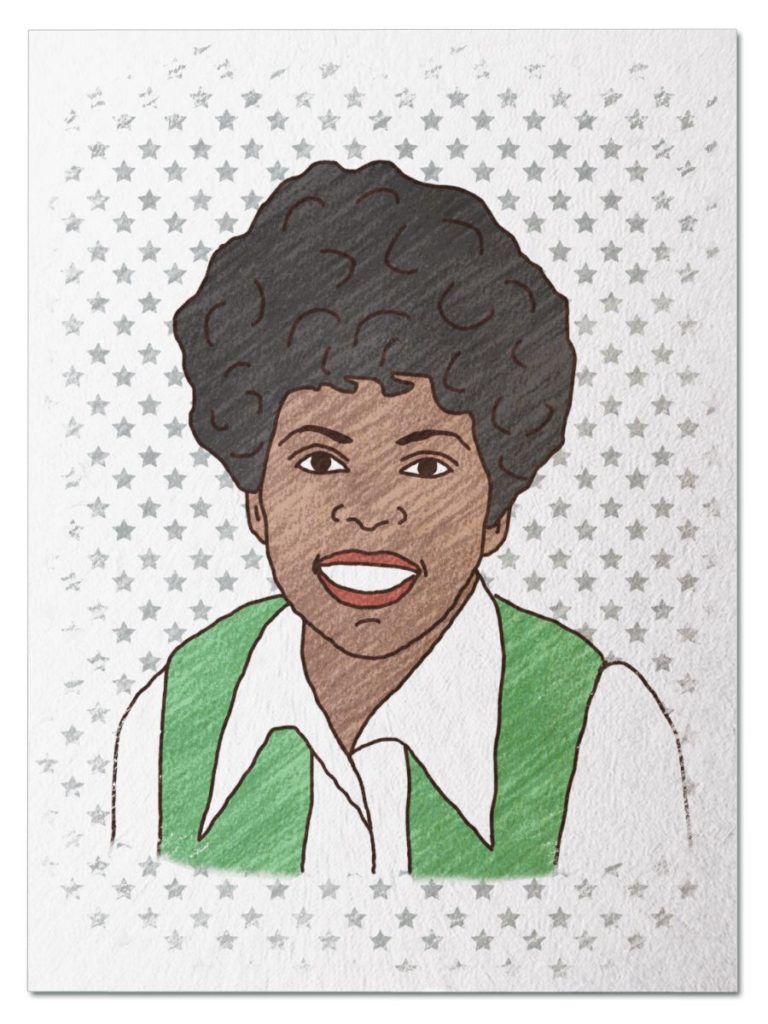
Exceptional Entertainer
She grew up on a farm in western Michigan and ended up one of the original “people in your neighborhood” in a corner of the city called Sesame Street. She spent 48 years with Big Bird, Oscar the Grouch, and a wide group of adults, kids, and Muppets of all kinds as the experimental show she took a chance on became a worldwide phenomenon for generations of kids. Walk onto the 1969 set at PBS Studios and meet Susan, aka Loretta Long…
Her Ruby Shoe Moment
The Power of the Wand
Her Yellow Brick Road
Brains, Heart & Courage
Glinda’s Gallery
Just the Facts
Her Ruby Shoe Moment
Loretta Long laughed as she looked around. Her co-stars were a little different than she was used to – among her fellow actors were furry fluffy puppets (called Muppets) with big personalities! It was 1969, and Loretta was filming the first episode of a show called “Sesame Street.” She had been hired to play a woman named Susan, one of the humans who lived in the neighborhood.
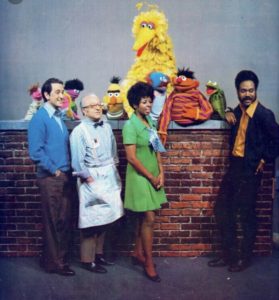
The original cast of Sesame Street – humans and Muppets!
Until now, children’s television had typically consisted of a group of kids sitting in a circle, listening to an adult talk or perform. The creators of Sesame Street were looking to do something completely new. They wanted kids at home to feel like they were part of a community and to participate along with the show. The setting they chose was an inner city neighborhood filled with people of various races.
Loretta remembered nervous she had been to call her parents to tell them she was quitting her teaching job to join the cast of Sesame Street. She knew her description of her new job sounded crazy: she was playing a woman who lived in on an urban street who spent much of her time talking to an 8 foot tall yellow bird who lived in a big nest below her window. She decided not to even tell them that another one of her neighbors on the show was a green “Grouchy thing” who lived in a trash can. They were already concerned that Loretta had made a huge mistake.
But once the show aired, her parents quickly realized that Loretta was having a bigger impact than she ever would have had she stayed in the classroom. Loretta’s character Susan, along with Matt Robinson, who played her husband Gordon, were one of the first Black married couples ever portrayed on television.
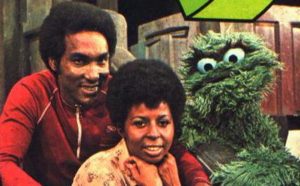
With neighbor Oscar the Grouch
Susan was the only woman of the four original human characters (the others were Mr. Hooper, Bob, and Gordon). The show creators asked each of them to write a “Bible” for their characters that detailed their past lives before they moved to Sesame Street. Loretta used much of her own biography (i.e. Susan had moved to the city from the Midwest), but decided that Susan had studied nursing in college instead of education.
Sesame Street got a lot of attention from the start because it was so different. The actor who played Mr. Hooper was also an acting coach, and he helped the human and Muppet cast members run their lines. Loretta quickly realized that she would be more effective if she threw herself into her interactions with the Muppets as if they were real, and not puppets. The puppeteers behind the scenes made that easier, as they created distinct personalities for each of them.
But the show was definitely a work in progress. During the first season, the National Organization of Women (NOW) noticed that Susan’s role was primarily waving out of the window of her apartment. They approached the producers of Sesame Street (many of whom were, ironically, women) and suggested that they allow Susan to do more.
 Loretta was excited to read the script that came out of the NOW meeting – Susan sat down with Gordon and told him that she had decided to go back to work because she wanted to use her nursing degree to help people. It was important to Loretta that Susan wasn’t asking for permission, but explaining to a supportive husband that she wanted to return to her profession.
Loretta was excited to read the script that came out of the NOW meeting – Susan sat down with Gordon and told him that she had decided to go back to work because she wanted to use her nursing degree to help people. It was important to Loretta that Susan wasn’t asking for permission, but explaining to a supportive husband that she wanted to return to her profession.
From then on, Susan shared stories about her job with the neighborhood kids and Muppets and talked about what it was like to be a working woman. One of Loretta’s main requirements for Susan was that she never talked down or patronized the kids and Muppets, but instead indulged their curiosity and was always ready to have a laugh.
Loretta and the writers continued to use Susan’s character to break down stereotypes. Susan became the neighborhood expert on automotive repairs, and fixed many broken down cars and buses for the people (and Muppets) of Sesame Street. She and Gordon also adopted a son, who they named Miles, in the 1986 season of the show – this was one of the first times an adoptive family was featured on television.
The Power of the Wand
Loretta was one of 4 original human cast members on Sesame Street, and she played Susan for 48 years. Since she joined the show, there have been many other humans who have moved onto Sesame Street to live with their Muppet neighbors. One of the newest cast members, and the first child to join the show in 20 years, is Charlotte “Charlie” played by Violet Tinnirello. Charlie moved onto Sesame Street in 2020 with her parents after they retired from the military. Check your local PBS listings to see what she is up to today!
Her Yellow Brick Road
Loretta moved from Michigan to New York City in her early 20s to try to make it in show business. She supported herself by working as a substitute teacher in the Bronx public schools. She didn’t want to commit to a full-time position because she was “an actor and a singer who happened to be teaching. I wasn’t a teacher who wanted to be in show business.” She wanted to be free to accept any big break that came her way.
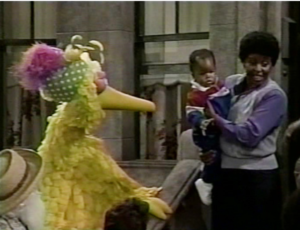
Susan with adopted baby Miles and Big Bird
Her junior high age students loved her because she was fun and used her acting skills in her lessons. She was often in trouble with administrators because her students were laughing too much and her classrooms were too loud. Her students found it funny that she was in the principal’s office more often than they were!
In her spare time she went to as many auditions as possible. She got her first big break when she got a gig as a co-host on a variety show called “Soul!” The show was broadcast on New York’s PBS channel and featured many up and coming soul artists, like Stevie Wonder, Gladys Knight, and Patti LaBelle. Loretta interviewed the singers before their performances, and every now and then got to sing herself.
The PBS studios were a busy place. Loretta noticed that her friend, Soul! set designer Charles Rosen, was working on another project. She walked over to investigate and saw he was building a set that looked like an urban street, with apartments and storefronts. He had twin toddler sons, so Loretta asked if he was building something for his boys to play in. Charles said no – the set was for an experimental educational show for preschoolers that PBS was planning.
Charles told Loretta the show was going to be a combination of puppet characters and 4 “human hosts” that would be educational guides. He knew Loretta was a teacher and suggested she audition. She initially said no – the “kiddie tv” she had seen had prim and proper ladies talking down to kids, which she found annoying. Charles told her that the whole point of the show was to be different, and that she should at least go to the audition to see what it was all about.
When Loretta showed up at the audition, everyone else there was holding a guitar. It turned out that Charles had either not known or not told her that the casting directors were looking for a “Joan Baez folk guitar type lady.” They met Loretta at the door and asked if they could help her. When she said she was there for the audition, they asked “where’s your guitar.” And when she said she didn’t have one, they told her to go stand in the corner and wait.
Loretta briefly considered leaving but decided that she had nothing to lose by staying. She watched as the other performers took their turn auditioning. The casting directors were recording them, and Loretta noticed that most of them were too focused on their guitar to be looking into the camera. When they all finished, the casting directors started packing up their things to leave, having forgotten all about Loretta. Loretta approached their table and said “I came to sing for you.” They shrugged and told her to go ahead.
 Loretta had been planning to sing a show tune from a musical, but watching the guitarists do their own thing and ignore the camera had convinced her to make a last minute change. She reached into her babysitting/camp counselor memories and decided to sing a song she knew little kids loved: My Little Teapot. She looked directly into the camera, tapping her foot and clapping her hands. She sang the lyrics (“I’m a little teapot short and stout. Here is my handle and here is my spout. When I get all steamed up hear me shout. Tip me over and pour me out”) and did the motions along with it. She then said “Everybody sing” and performed it again.
Loretta had been planning to sing a show tune from a musical, but watching the guitarists do their own thing and ignore the camera had convinced her to make a last minute change. She reached into her babysitting/camp counselor memories and decided to sing a song she knew little kids loved: My Little Teapot. She looked directly into the camera, tapping her foot and clapping her hands. She sang the lyrics (“I’m a little teapot short and stout. Here is my handle and here is my spout. When I get all steamed up hear me shout. Tip me over and pour me out”) and did the motions along with it. She then said “Everybody sing” and performed it again.
The casting directors took all the tapes from the auditions and showed them to a group of 4 year olds in a day care. They wanted to see who the kids responded to the most. And when they saw Loretta looking right at them encouraging them to sing, they all stood up and joined in the song! Loretta thought it was wonderful that “I have some 4-year-olds to thank for my career.”
Brains, Heart & Courage
Loretta grew up on a 40 acre farm near the western Michigan town of Paw Paw with her parents, brother, and sister. They were one of two Black families in town. Loretta’s dad was a welder by day and then worked the farm when he got home. He had lights on his tractor so he could work well into the night. The kids spent most of their free time working the farm. Loretta also loved to fish and read when she had time – one summer she read the entire encyclopedia from A-Z.
Loretta’s favorite thing to do in her spare time was spend singing and dancing. She loved it and dreamed of a career in show business, even though there wasn’t much inspiration around her. Her town only had one movie theater, which almost exclusively played cowboy movies (which had no Black characters and usually one 1-2 women). And televisions were few and far between – her family didn’t have one until she was a teenager and even then, the reception was terrible.
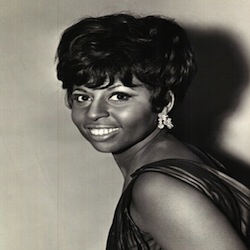
Loretta
So Loretta indulged her love for music by making up songs and dances to keep her occupied when she worked at the farmstand in front of her house where her parents sold fruits and vegetables. She became a draw for customers, as people driving by often stopped to see what she was performing and then bought whatever produce she was selling that day.
Loretta’s parents had a traditional career in mind for her. Neither of them had gone to college, and they wanted her to get a degree become a teacher or a nurse. Loretta really wanted to be an actress, but she also knew for sure she didn’t want to be a farmer and college was her ticket out. Her family couldn’t afford to send her without a scholarship, so she studied hard in high school to earn one. She was the only Black student in her class and while most of the students accepted her, she faced discrimination from the administrators, who prevented her from representing the school as a cheerleader and drum majorette.
Loretta’s parents were thrilled when, after graduation, she enrolled in the education program at Western Michigan University. But she couldn’t completely ignore the voice inside of her that wanted to perform, so she also took theater classes and won roles in some productions. And after she graduated from WMU in 1960. She wanted to try living in a big city and had aspirations to be a Motown singer, so moved to Detroit. She spent a year teaching junior high school and debating her next move. She could either follow the safe path and stay in Michigan or throw caution to the wind to really try for a career as an actress and singer. She chose her dream, and moved to New York City.
Glinda’s Gallery
Just the Facts
- Loretta Mae Moore was born on October 4, 1938 in Paw Paw, Michigan.
- Loretta was married briefly and kept her ex-husband’s last name, Long, after they divorced.
- In 1971, only two years after Sesame Street debuted, Western Michigan University gave Loretta its Distinguished Alumni Award.
- Loretta earned her Ph.D. in Urban Education from the University of Massachusetts Amherst in 1973. She commuted there on her days off from taping Sesame Street. Loretta wrote her Ph.D. dissertation on Sesame Street’s innovative approach combining education and entertainment. She titled it “Sesame Street: A space age approach to education for space age children.” Loretta’s thesis was that Sesame Street, by setting its discussion of letters, numbers, science, and friendship in a world inhabited by people of multiple races and ethnicities, both improved educational outcomes for minority children and benefitted all children by showing them a functional and fun multi-cultural world.
- Three different actors played Susan’s husband Gordon: Matthew Robinson, Hal Miller, and Roscoe Orman.
- Loretta retired from Sesame Street in 2017. She still teaches and gives lectures on multicultural education.
Want to Know More?
Long, Loretta & Alboum, Scott Howard. From Paw Paw to Sesame Street: My Journey (CreateSpace Independent Publishing 2015)
Long, Loretta. My Best Friends Call Me Susan (CreateSpace Independent Publishing 2016)
Flynn, Eric. “Loretta Long: From Big Dreams to Big Bird, She Used Her Talents to Educate Millions” (Western Michigan University News Feb. 12, 2021).
Tulp, Austin “Sesame Street and Beyond: Loretta Long” (Ferro Productions Jan. 2, 2013).
Soberman, Matthew “Important Muppet People: Loretta Long” (Tough Pigs July 3, 2020).
Staff. “The Interviews: Loretta Long” (Television Academy)
